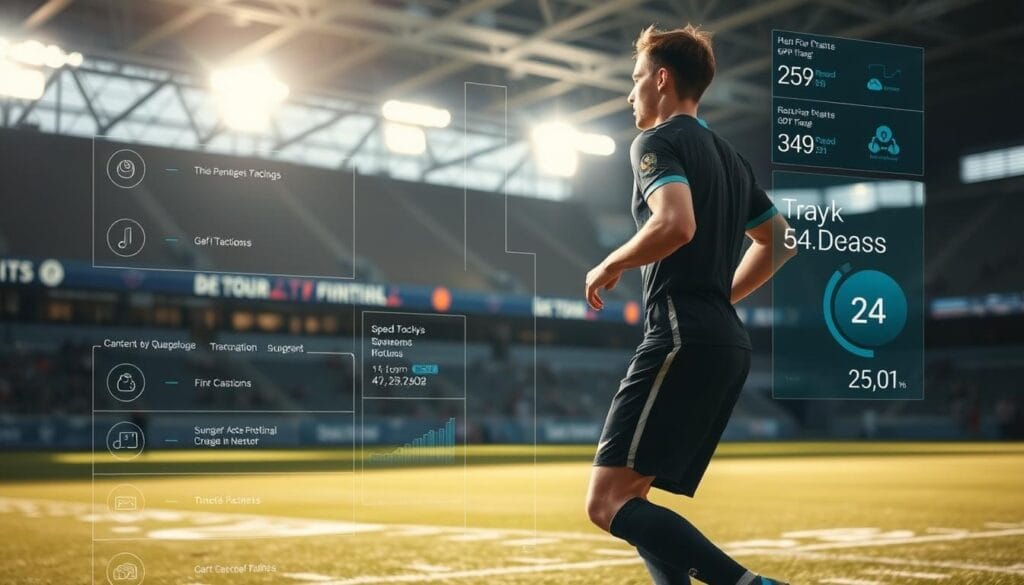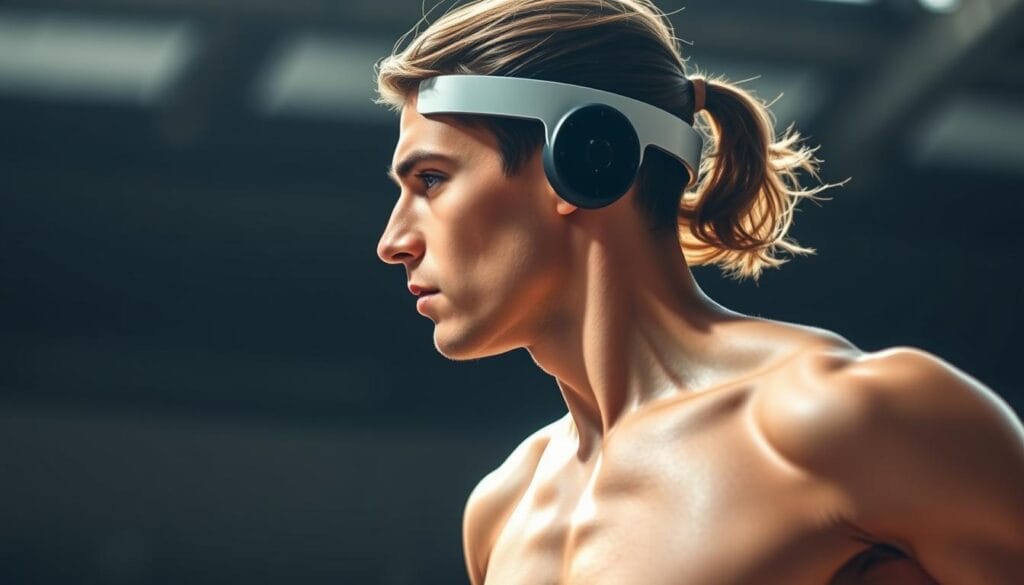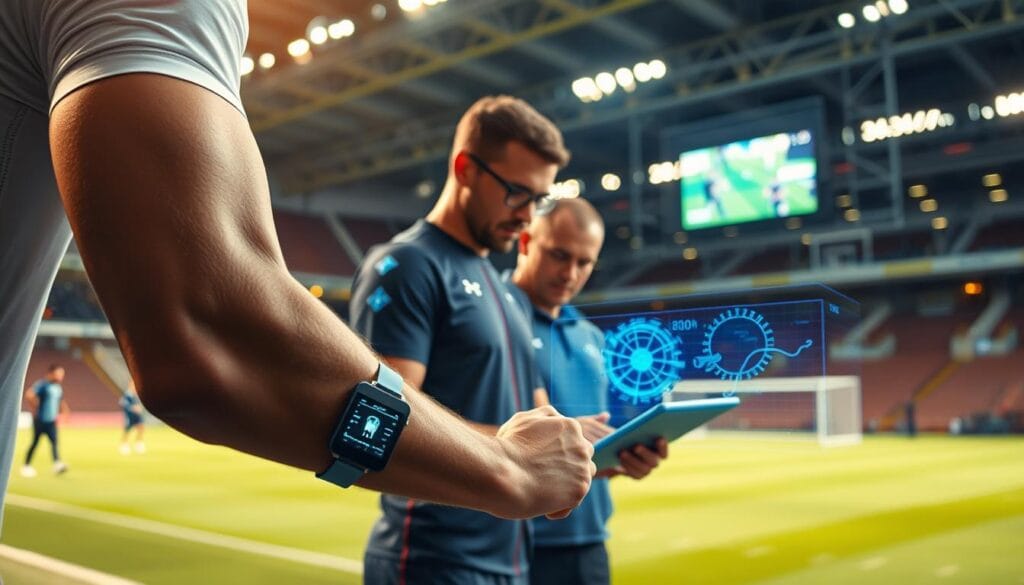
Technology is playing a big role in sports, especially in football. Biometric technology is becoming more important. It helps us understand a player’s physical abilities better.
This new tech lets coaches improve training plans. It helps them find and use a player’s full potential. Thanks to wearable sensors, coaches can make better tactics. This boosts player performance and gives teams an edge.
Key Takeaways
- Biometric technology is changing football by giving insights into player performance.
- Wearable sensors help coaches create training plans that fit each player’s needs.
- Biometric data improves how coaches make tactical decisions in football.
- Coaches can now track player health and how tired they are more accurately.
- The use of wearable sensors will keep shaping football tactics in the future.
The Evolution of Football Analytics
Football analytics has changed the game, helping coaches make smarter choices. Now, teams use advanced stats to get ahead. This is a big change in how they play.
From Basic Statistics to Advanced Metrics
Before, football analysis was simple, focusing on things like who had the ball most. But now, thanks to sports technology innovation, it’s much more detailed. We track how far players run, how fast they go, and how quickly they can change direction.
The Digital Revolution in Sports
The digital age has changed football analytics a lot. Coaches use new tech and software to look at real-time data. This lets them adjust their plans on the fly, making the game more strategic.
As football keeps evolving, analytics will play an even bigger role. Teams that use football performance analysis will stay on top. They’ll make choices that help them win more games.
Biometrics in Football Wearable Sensors: A Comprehensive Overview
Wearable sensors are changing football by giving real-time biometric data. This tech lets coaches and trainers make better decisions. It boosts player performance and team strategy.
Types of Biometric Data Collected
Wearable devices collect many types of biometric data. These include physical and performance metrics. They are key to knowing player fitness, fatigue, and performance.
- Heart Rate: Monitoring heart rate shows how hard players are working and how they recover.
- GPS Tracking: GPS data gives insights into player movement, speed, and distance during training and games.
- Acceleration and Deceleration: These metrics show the intensity of player movements.
Common Wearable Devices in Professional Football
Professional football teams use many wearable devices to get biometric data. The most common ones are:
GPS Tracking Vests
GPS tracking vests are worn by players during training and games. They give real-time data on player movement, speed, and distance.
Heart Rate Monitors and Physiological Sensors
Heart rate monitors and other physiological sensors track player exertion, fatigue, and recovery. This info is crucial for improving training and preventing injuries.
By using these wearable technologies, football teams can get ahead. They get insights into player performance and health through data.
Case Study: NFL’s Adoption of Wearable Technology
The NFL is changing fast, thanks to wearable tech. Teams are using player tracking technology to get ahead. This tech helps them plan better and improve how players perform.
The Kansas City Chiefs are leading the way. They use gps tracking in sports to track players’ movements and speeds. This helps coaches make smart decisions during games and practices.
Kansas City Chiefs’ Data-Driven Championship Strategy
The Chiefs use wearable tech in many ways. They track player workload with GPS to prevent injuries and boost performance. This data helps create training plans that fit each player’s needs.

San Francisco 49ers’ Performance Innovation Lab
The San Francisco 49ers also use wearable tech through their Performance Innovation Lab. They use data and wearables to innovate in training and performance. This lets them understand player fatigue and fitness levels better.
Both the Kansas City Chiefs and San Francisco 49ers show how wearable tech is changing the NFL. By using player tracking technology and gps tracking in sports, they’re raising the bar for performance and competition.
Real-Time Performance Monitoring on the Field
Real-time performance monitoring is changing football. Coaches can now make decisions based on data during games. This is thanks to wearable tech that tracks important health data, giving a full picture of a player’s state during play.
In-Game Tactical Adjustments
With real-time data, coaches can make in-game tactical adjustments to improve team performance. For example, if a player’s heart rate or fatigue shows they’re tired, the coach can swap them out for a more energetic player. This used to be based on just watching; now, it’s backed by actual data.
- Monitoring player fatigue to prevent injuries
- Adjusting team formations based on real-time performance data
- Identifying the most effective players on the field at any given time
Load Management During Competitive Play
Load management is key to avoid burnout and injuries in competitive play. Wearable sensors track the physical load on players. This lets coaches manage how hard players work during the game and the season.

Real-time monitoring helps coaches boost team performance and keep players healthy. It prevents overwork and injuries, helping players have longer careers. This new way of managing players is changing how teams compete and win in football.
Training Optimization Through Biometric Insights
Biometric insights are changing how football teams train. They help create personalized and effective plans. Coaches use data from wearable sensors to improve player performance and lower injury risks.
Personalized Training Regimens
Biometric data lets teams make customized training plans. These plans are based on each player’s unique body profile. They use heart rate variability, GPS tracking, and other metrics for this.
For example, a player recovering from an injury gets a special training plan. This plan increases intensity and volume slowly. It’s monitored closely to avoid overdoing it. As USA Today said, “Wearable technology has changed how teams develop players and prevent injuries.”
Recovery Protocol Development
Recovery is key in any training program. Biometric insights help create effective recovery plans. They analyze data on fatigue, sleep, and other recovery metrics to tailor strategies.
Sleep Quality Assessment
Sleep quality is crucial for recovery. Wearable tech tracks sleep patterns to find ways to improve. NFL coach Andy Reid said, “Rest is huge for recovery. We check our players’ sleep to make sure they rest well.”
“The way we use data to drive our training and recovery protocols has been a major factor in our success this season.”
Nutrition Planning Based on Metabolic Data
Nutrition planning also benefits from biometric insights. Teams use metabolic data to create nutrition plans. These plans match a player’s energy needs and dietary requirements, boosting their field performance.

By using biometric insights in training, football teams can get ahead. They improve player performance and team success.
Injury Prevention and Management
Biometric sensors are changing how football teams handle injuries. They watch physiological data closely. This lets coaches and trainers spot and stop injuries before they happen.
Identifying Fatigue and Overtraining Markers
Biometric data is key in spotting when players are too tired or overworked. Wearable devices track heart rate, sleep, and muscle fatigue. This helps coaches adjust training to keep players safe and performing well.

Rehabilitation Progress Tracking
Biometric data is also crucial for tracking injured players’ recovery. It looks at range of motion, strength, and flexibility. This way, trainers can make recovery plans that fit each player’s needs, helping them get back to playing safely and quickly.
Reducing Career-Threatening Injuries
The main aim is to cut down on injuries that can end a player’s career. Biometric data helps teams spot risks early and take steps to prevent them. This approach keeps players safe and helps the team succeed.
In short, using biometric data for injury prevention is changing football. It gives teams insights into player health and performance. This helps them make better decisions, reducing injuries and boosting their chances of winning.
Tactical Revolution: How Coaches Leverage Biometric Data
Coaches are now using biometric data to change how they play football. They use advanced sports analytics to make better decisions. Biometric data gives them lots of info on how players perform. This helps them tweak their strategies.
Formation and Position Adjustments
Biometric data helps coaches see how fit their players are. If a key player is not fully recovered, they might change the formation. This data-driven approach helps teams adjust better to different game situations.
Player Selection Based on Fitness Metrics
Coaches can pick players based on their fitness levels now. Wearable tech gives them insights. They can see who’s at their best and choose the starting lineup wisely. This way, the most skilled players are on the field when it counts.
Opponent Analysis and Counter-Strategies
Biometric data is also key in analyzing opponents and planning counter-strategies. By looking at the fitness and performance of opposing teams, coaches can find weaknesses to exploit. This football performance analysis helps teams prepare better strategies to beat their opponents.
As sports analytics in football keeps growing, we’ll see more creative uses of biometric data in the future.
Case Study: College Football’s Technological Transformation
College football teams are now using advanced technology to track player performance. This change is making the game more competitive. Teams are using data to improve their strategies and player skills.
Alabama Crimson Tide’s Performance Analytics Program
The Alabama Crimson Tide is leading this technological change. They use advanced tracking to monitor players in real-time. This helps them make better decisions and improve their team.
Ohio State’s Competitive Edge Through Technology
Ohio State is also using technology to get ahead. They track player performance to fine-tune training and recovery. This has helped them stay competitive in the Big Ten.
Individual Player Success Stories
Many players have seen benefits from these technologies. For example, injured players can now return faster thanks to better recovery plans. This is thanks to data-driven approaches.
| College Team | Technology Used | Outcome |
|---|---|---|
| Alabama Crimson Tide | Advanced Player Tracking | Improved Player Performance |
| Ohio State | Athletic Performance Monitoring | Enhanced Recovery Times |
| Other Teams | Sports Analytics Software | Better Strategic Decisions |
Wearable technology and data analytics are changing college football. They help teams improve player performance, recovery, and strategy. This is making the game more competitive and exciting.
Challenges and Limitations of Biometric Technology
Biometric technology is becoming more common in football. But, it also brings challenges that affect its use. Wearable sensors and data analytics have changed the game. Yet, we must also think about the problems they bring.
Data Privacy Concerns
Data privacy is a big worry. Sensitive player info is being collected and stored. This raises the risk of data breaches and unauthorized access. It’s crucial to have strong security to keep this data safe.
Accuracy and Reliability Issues
The accuracy and reliability of biometric data are key. Inaccurate data can lead to misinformed decisions, impacting player performance and team strategy. It’s important to regularly check and validate gps tracking and wearable tech to ensure it’s right.
Player Resistance to Constant Monitoring
Some players might not like being constantly monitored. They worry about privacy and feeling too watched. You can help by being open about data use and showing how it helps the team.
By tackling these issues, you can make the most of biometric tech in football. This way, you can enjoy its benefits while avoiding its downsides.
The Future of Biometrics in Football
Football is changing fast, with biometric tech leading the way. This shift means more data will guide how players perform and teams strategize. It’s a big leap towards a more data-driven game.
Emerging Technologies and Innovations
New tech like AI and machine learning will change football. Wearable technology for athletes is getting better. It lets coaches track player health and performance more accurately.
Predictive Analytics for Performance
Coaches will use predictive analytics to make better choices. They’ll pick players, plan training, and set game tactics based on biometric data in sports performance. This way, teams can spot problems early and keep players healthy.
Soon, coaches will get automated advice on tactics based on data. This will give teams a competitive edge. It’s all about making smart decisions based on data to boost performance.
These new technologies will not only make players better but also change how teams play. By using wearable technology for athletes and biometric data in sports performance, teams can understand player health and performance better. This leads to better athlete performance overall.
Conclusion
Wearable sensors are changing football in big ways. They help coaches make better plans and improve player skills. This gives teams an edge over their rivals.
Teams use biometric data to make smart choices. They can lower injury rates and boost performance. Wearable sensors let coaches track player fatigue and tailor training and recovery plans.
As tech gets better, we’ll see new uses of biometrics in football. The Kansas City Chiefs and San Francisco 49ers are already winning with wearable tech. Soon, more teams will join them.
You now know how biometrics is changing football. With wearable sensors becoming more common, the future looks bright. There’s a lot of room for growth and new ideas.
FAQ
What is the role of biometrics in football?
Biometrics help coaches understand how players perform. They use this data to make better decisions and improve training.
How do wearable sensors contribute to football analytics?
Wearable sensors track player movement and speed. This data helps coaches understand player performance better.
What types of biometric data are collected in professional football?
Professional football collects heart rate, GPS data, and more. These metrics help coaches understand player health and performance.
How is wearable technology being used in the NFL?
The NFL uses wearable tech to improve player performance. Teams like the Kansas City Chiefs use data to gain an edge.
What are the benefits of real-time performance monitoring in football?
Real-time monitoring lets coaches adjust strategies during games. It helps manage player load and improve team performance.
How can biometric insights be used to optimize training?
Biometric insights help create personalized training plans. They guide recovery and monitor fatigue, improving athlete performance and safety.
What is the role of biometric data in injury prevention and management?
Biometric data helps prevent injuries by tracking fatigue. It also monitors rehabilitation, reducing the risk of serious injuries.
How do coaches leverage biometric data to inform their tactics?
Coaches use biometric data to adjust formations and select players. It helps develop strategies against opponents.
What are the challenges and limitations of biometric technology in football?
Biometric tech faces challenges like data privacy and accuracy. Players may also resist constant monitoring.
What is the future of biometrics in football?
The future of biometrics in football will see new technologies. Advancements will enhance player performance and competitive edge.
How is college football leveraging biometric technology?
College football teams use biometric tech to improve player performance. It helps them gain an edge and achieve success.
What are some common wearable devices used in professional football?
Professional football uses GPS, heart rate monitors, and other sensors. These devices track player movement and health.




